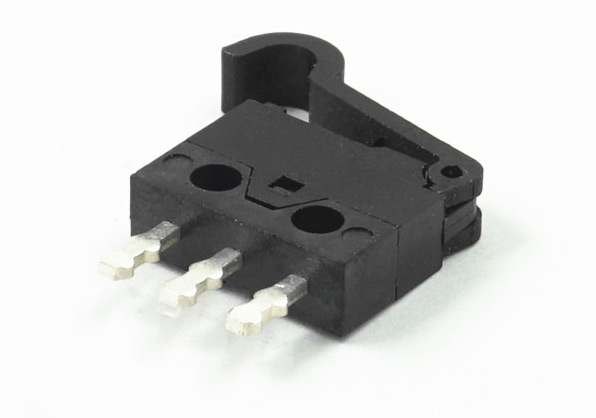
Size is important when selecting a microswitch, and switch size is directly related to its characteristics, including current range, travel, and operating force. For example, one of the smallest microswitches on the market today measures 0.50" x 0.236" x 0.197" (L*W*H). While this tiny switch is suitable for detecting circuit conditions in compact circuit breakers, it typically only interrupts 0.1 to 3 amperes (A) and has a short travel. Microelectronics reminds that the smaller the size of the switch, the smaller its stroke and the current that can be interrupted.
2. Electrical requirements
Micro switches are usually capable of breaking currents from 5mA/5VDC to 25A/250VAC. The micro switch product line provides a range of products from low energy consumption to power load electrical types for a variety of applications. The current and voltage rating (AC or DC) required for a specific application must be known to select the appropriate switch.
3. Environmental conditions
Environmental requirements have a great influence on the selection of micro switches, especially in high reliability and critical applications such as industrial control and medical equipment. Understand the environmental conditions of the application, including contaminants in the air that may enter the switch, the liquid in which the switch is located, and operating temperature requirements.
4. Reliability (service life)
The reliability of the micro switch is very important. It is necessary to determine how many times the electrical and mechanical operation life is required for an application. Different switches have different contact materials, shells and terminals, which can meet the electrical and mechanical life requirements in different applications. A highly reliable microswitch can operate 10 million to 20 million times before mechanical failure, and 50,000 to 100,000 times under maximum load before electrical failure.
5. Institutional Certification
Choosing switches that meet various international electrical requirements can help you simplify product design for different regions. Some major standard certifications include UL certification in the United States, cUL certification or CSA certification in Canada, ENEC certification in Europe, and CQC certification in China.
Notes on using microswitches
One: Please note that the circuit setting (software setting) should be based on the beating and vibration specified by each type of micro switch to form a combined component so that no malfunction will occur.
Two: The carbon contact point of the micro switch has the characteristic of changing the contact resistance due to the pressing load. When used in a voltage divider circuit, etc., use it after sufficient confirmation.
Three: The micro switch is designed and manufactured on the premise of DC resistive load. When using other loads (inductive load (L), capacitive load (C)), please confirm separately.
Four: When the micro switch is welding the terminals, if a load is applied to the terminals, there may be loosening, deformation and deterioration of electrical characteristics due to different conditions. Please pay attention when using it.
Five: The micro switch should not be used continuously for a long time near the upper limit and the lower limit of the operating temperature range. If it is used beyond the rated voltage, there will be a possibility of poor contact. within the scope of environmental testing.
Six: Regarding the setting of the microswitch welding conditions, please do it according to the actual mass production conditions. The water-soluble flux may corrode the switch during welding, so please avoid using it.
One: Please note that the circuit setting (software setting) should be based on the beating and vibration specified by each type of micro switch to form a combined component so that no malfunction will occur.
Two: The carbon contact point of the micro switch has the characteristic of changing the contact resistance due to the pressing load. When used in a voltage divider circuit, etc., use it after sufficient confirmation.
Three: The micro switch is designed and manufactured on the premise of DC resistive load. When using other loads (inductive load (L), capacitive load (C)), please confirm separately.
Four: When the micro switch is welding the terminals, if a load is applied to the terminals, there may be loosening, deformation and deterioration of electrical characteristics due to different conditions. Please pay attention when using it.
Five: The micro switch should not be used continuously for a long time near the upper limit and the lower limit of the operating temperature range. If it is used beyond the rated voltage, there will be a possibility of poor contact. within the scope of environmental testing.
Six: Regarding the setting of the microswitch welding conditions, please do it according to the actual mass production conditions. The water-soluble flux may corrode the switch during welding, so please avoid using it.


